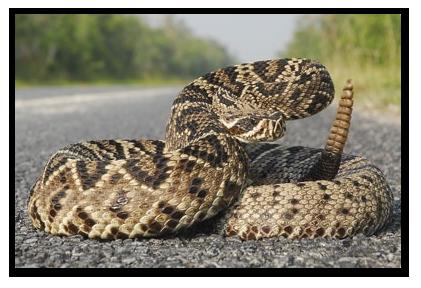Eastern Diamondback Rattlesnake
(Crotalus adamanteus)The photographer saw this snake basking beside a back-country road in what appears to be North Florida.
It's a rather typical adult Eastern diamondback (about five-and-a-half feet long and about five or six pounds in weight). It has the clearly marked diamond-shapes extending most of the length of the snake's body (each of the diamonds outlined in yellowish scales). It also has a well-shaped rattle.
Notice how the snake's head and about a third of its length are lifted above the rest of the body. The rattles are erect, positioned to buzz eerie "stay-away-from-me" warnings. Out in the open with no close-by place to hide, the snake feels threatened and is ready to defend itself. It is ready to strike if the threat comes much closer.
How much closer? A typical diamondback like this one can accurately strike at threats that get within five or six feet. And photo-journalists are on the diamondback's list of human threats.
********************
Here's a close-up of a diamondback striking.
Swift, accurate, and deadly, a strike like this takes less than a second.
A diamondback strike seldom misses. (Even in near total darkness this snake can strike with pinpoint accuracy because of its ability to detect infra-red radiation from the body heat of the mice, rats, rabbits, and squirrels that it preys on. But more about the infra-red detection later.)
And those fangs (which are about three-fourths of an inch long) are just like hypodermic needles loaded with a venom that is both hemotoxic and neurotoxic. That is, the venom destroys blood cells and damages the central nervous system. It also begins the digestion of the prey even before the animal is eaten by the snake.
